Trek-A-Sat- MS
Topic outline
-
 Written By: Frances Dellutri, Middle School/Intermediate Level EIS Education Team, June 2016
Written By: Frances Dellutri, Middle School/Intermediate Level EIS Education Team, June 2016 EIS Topic: Atmosphere, Centripetal Force, Computers, Mathematics, Micro-gravity, Free-fall, Orbital Mechanics, Physics, Satellites, Spacecraft, Weightlessness
Grade (Age) Level: Grades 5-8 (Ages 10-13)
Key Topics Associated with Standards: Collecting, Analyzing and Interpreting Data; Gravitational Interactions; Forces and Motion, Relationship between Energy and Forces
A satellite is moving overhead every few minutes and it's fun to be able to identify them, watch for them, and track them. This project gives great direction on how to track satellites overhead, both visually and electronically.
Trek-A-Sat gives you the tools to track a satellite in the sky right now in real time!
If you would like to learn more about satellites, their orbits and the forces involved with orbiting satellites, log into The EIS Academy and learn about satellites in the lesson called "Satellites - Understanding How They Work! "
https://www.eisacademy.org/course/view.php?id=54
If you are ready to start tracking satellites, move ahead to join the lesson where you wish!
INDEX
Section 1. Trek-a-Sat
Section 2. Understanding Where Satellites are Found
Section 3. Looking at Factors That Affect the Orbit Time and Position of Satellites.
Section 4. How did You Use this Lesson
-
 Here is a great activity that gives you the tools to track a satellite right now, in real time. Enterprise In Space has its mission to launch, orbit and recover the NSS Enterprise, a satellite carrying 100+ experiments designed by students K - University and you will be able to track its journey upon launch in 2020-2021. Follow the steps below to track the satellite in which you have an interest. If you would like to find out more about predicting where satellites will be and how to view them in the night sky, take a look at the other projects under this lesson. There are tracking logs and maps in the resources at the bottom of this lesson.
Here is a great activity that gives you the tools to track a satellite right now, in real time. Enterprise In Space has its mission to launch, orbit and recover the NSS Enterprise, a satellite carrying 100+ experiments designed by students K - University and you will be able to track its journey upon launch in 2020-2021. Follow the steps below to track the satellite in which you have an interest. If you would like to find out more about predicting where satellites will be and how to view them in the night sky, take a look at the other projects under this lesson. There are tracking logs and maps in the resources at the bottom of this lesson. Another lesson explores how satellites orbit and the forces involved with their orbit. It is found at:
European Space Agency Image
Best of luck tracking!
Trek - A - Sat Log Instructions Satellite:______________________
Date of Tracking:_______________________ Tracker: ________________________________
Supplies needed: pencil, colored pencils. Log and map printed out for this activity.
1. Go to website: N2YO.com http://www.n2yo.com/?s=27422
Register on the website If you wish for the website to note your tracking location and access to other options. It is not necessary to register to complete this activity.
2. Select the satellite you would like to track from the ribbon located at the top of the webpage. If you have a partner, have them track another satellite during the same time period on a separate log.
3. Determine the period of time you wish to record the selected satellite. . Decide how often you will be doing this (every minute, every two minutes).
4. Record the time, latitude, and longitude degrees (without minutes) in the Satellite Tracking Log.
5. Using your recordings, plot the satellite's progress on the map using the latitude and longitude recordings.
6. Use different colors for multiple satellites. Connect your markings with a solid line.
7. With a dashed line, extrapolate where you think the satellite's path will continue.
-
File
-
